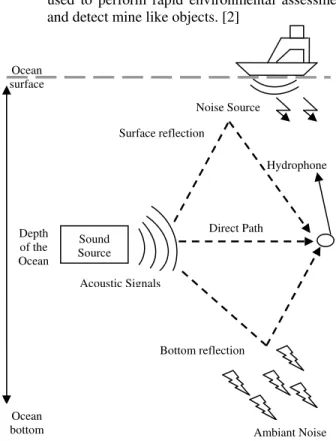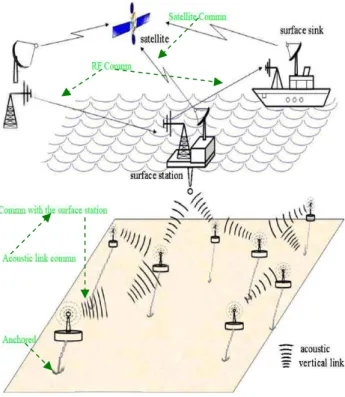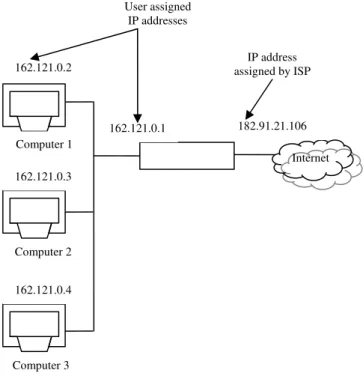An Empirical Study of Underwater Acoustic Sensor Network and
Terrestrial Wireless Network
Mohd. Ehmer Khan1, Farmeena Khan2 1
Department of Computer Science, Singhania University Jhunjhunu, Rajasthan, India
2
Department of Computer Science, EIILM University Jorethang, Sikkim, India
Abstract
Two third of the earth is covered with water and there has been a growing interest in monitoring underwater medium for scientific exploration and attack protection. Underwater sensor nodes will find application in ocean-graphic data collection, pollution monitoring, disaster prevention and tactical surveillance application. Underwater network consist of a variable number of sensors and vehicles that are deployed to perform collaborative monitoring task over a given area. On the other hand the terrestrial wireless networks are the networks without cable and are very easy to install and offer portability and convenience which other network solutions do not offer. The terrestrial wireless networks utilized radio waves to maintain communication channels between computers. In our paper some of the fundamental key aspects of underwater acoustic communication are investigated and three different UASN architectures are discussed.
Keywords: Communication Architecture, Terrestrial Wireless Network, Underwater Acoustic Sensor Network, WWAN
1. Introduction
Underwater Acoustic Sensor Network (UASN): A collection of sensor nodes which communicates among them through the emerging underwater acoustic communication technology is known as UASN. Acoustic communication technology is the best choice when compare to the radio waves and optical waves that is why it was chosen for the communication in underwater. Underwater acoustic network gaining attention due to their importance in underwater applications for military and commercial purpose.
Some of the major applications of UASN are [1]
I. Exploring the unpredictable underwater world.
II. Reports Ocean related disaster like tsunanmi to coastal areas.
III. Exchange information among nodes.
IV. It can perform pollution monitoring in lakes and rivers e.g. Oil leakage, chemical pollution, biological pollution etc.
V. It can also helps in detecting minerals, oil fields etc.
VI. UAN with acoustic and optical sensors can be used to perform rapid environmental assessment and detect mine like objects. [2]
Fig. 1 Represent underwater acoustic environment Depth
of the Ocean Ocean surface
Ocean bottom
Sound Source
Direct Path Surface reflection
Bottom reflection
Hydrophone
Ambiant Noise Noise Source
Major challenges in the designing of UASN are [3]
I. Battery power is limited. II. Limited available bandwidth.
III. Due to corrosions underwater sensors are more prone to failure.
IV. Bit error rates are quite high. V. Propagation delay.
VI. Channel is severely impaired.
Terrestrial Wireless Network: Wireless network refers to any type of network that is not connected by cables or any kind of wires, instead it uses radio waves. Through wireless networking we can move our computer any where very easily. Wireless network uses air as medium. It provides us more privacy and security than before.
Some of the most important advantages of wireless networks are [4]
Mobility/Portability It is very cost effective. Convenient to use. Easy deployment Expendability
Fig. 2 Represent wireless network
But with all these advantages there are certain disadvantages also such as [5]
Security: If wireless networks not secure properly it can be hacked easily.
Speed: The speed of wireless networks is far slower than wire network.
Reliability: Wireless networking signals are subject to a wide variety of interference.
2. Communication Architectures for
Underwater Acoustic Sensor Network
Three types of underwater acoustic sensor network are
2.1 Static-Two Dimensional UASN (for Ocean Bottom Monitoring)
Fig. 3 Represent architecture for static 2D UASN
It is a collection of sensor nodes that are anchored to the bottom of the ocean bed. The sensor nodes are connected to one or more sinks by the means of wireless acoustic links and have vertical and horizontal transceiver. Main application can be environmental monitoring. The major problem presented in this architecture is various multi-hopp paths which can increase signaling overhead over the networks as well as the complexity of routing protocols. [6]
Internet
Wireless router
Computer 3 (laptop) Computer 2
Broadband router connects to the internet
then connects to the router via cable
2.2 Static-Three Dimensional UASN (for Ocean Column Monitoring)
It is a collection of sensor nodes that are connected to the bottom of the ocean-bed by tethere. This technique can be used for surveillance monitoring of ocean phenomena.
Fig. 4 Represent architecture for static 3D UASN
Some major problems presented in this architecture are [6]
If the architecture is for military purpose than they can be easily detected by enemies.
It can obstruct ship navigating on the surface.
2.3 Three Dimensional Networks of Autonomous Underwater Vehicle (AUV)
In this architecture a sensor node is built inside underwater vehicle and is used to enhance the whole sensor network capabilities. It is necessary for this architecture to have algorithm that guarantee the perfect coordination between AUV and the sensors. It also ensures the correct functionality of AUV and sensors in the scenario. [6]
Two distinct characteristics of AUV are
Adaptive sampling Self configuration
Fig. 5 Represent architecture for 3D AUV
3. Various Terrestrial Wireless Networks
The four different types of terrestrial wireless networks are described below:
3.1 Wireless Personal Area Network (WPAN)
A wireless PAN involves some one wirelessly synchronizing his/her PDA to a laptop or desktop computer; it can also provide wireless connectivity to a printer. “Plugging in” (every device in a WPAN will be able to plug in to any other devices in the same WPAN) is the key concept in the WPAN technology. When two WPAN equipped devices come into close proximity, they can communicate as if they are connected by a cable. It can also prevent the unauthorized access to information as each WPAN equipped device has ability to lock out other device selectively. Two kinds of wireless technology used in WPAN are Bluetooth and infrared. [7]
3.2 Wireless Local Area Network (WLAN)
Using a wireless distribution method i.e. linking of two or more devices over a short distance (within a building) is called WLAN. The working of WLAN depends on three main parts; they are as follows [8]
1. Infrastructure mode 2. Ad-hoc network mode 3. Mixed network mode
Fig. 6 Represent WLAN architecture
WLAN architecture is a technique of arranging and designing of different components in WLAN networking device in a specific way.
Three important components of WLAN architecture are
1. Access Point 2. Clients 3. Bridge
3.3 Wireless Metropolitan Area Network (WMAN)
Fig. 7 Represent Wireless MAN
Wireless MANs are the type of wireless networks that connect several wireless LANs for e.g. WiMAX. Wireless MANs encompass areas of about the size of the cities and can span upto 50 kilometers. DQDB is the standard of WMAN which cover upto 48 kilometers with the speed of 34 Mbit/s to 155Mbit/s. WMAN performance varies, and the actual performance depends on the choice from the wide assortment of technologies. The technology of WMAN consists of ATM, FDDI and SMDS. WMAN
provide high speed internet access to business and thus opens the door for the success.
3.4 Wireless Wide Area Network (WWAN)
Wireless WANs covers large geographical area, such as country or continent. Data throughput rate for WWAN are a great deal slower, that is upto 170 Kbps and typical rates of about 56 Kbps. [9]
Fig. 8 Represent various components of WWAN
Various advantages of WWAN application involve user accessing internet wherever and whenever needed, stay connected while traveling, enabling users to carry on business and leisure activities form different location. With all these advantages there are certain limitations also, such as
1. Application persistence
2. Poor performance within buildings 3. Security
4. Expensive to install within buildings 5. Off-the-shelf solutions
Table 1: Comparing different terrestrial wireless networks
S.No. Types Coverage Standards
1. WPAN Within reach of a person
Bluetooth, IEEE 802.15 and Irda 2. WLAN Within a campus or
same building
IEEE 802.11, Wifi, Hyper LAN 3. WMAN Within a city
IEEE 802.16, WIMAX and proprietary 4. WWAN All over the world CDPD, 2G, 3G
and 3.5G Base
Station
Client on a laptop with a WAN RF device
Telephone Network
Internet Current
switched data
Packet switched data Switching
center computer Desktop
with Windows
NT 162.121.0.3
162.121.0.4 Computer 1
Computer 2 162.121.0.2
Internet
162.121.0.1 182.91.21.106
User assigned IP addresses
IP address assigned by ISP
Bridge Network
1
Network 1 Bridge
4. A Comparison between Underwater
Acoustic Sensor Network and Terrestrial
Wireless Network
The comparison between UASN and Terrestrial wireless network are described below: [1] [3]
1. The ground based wireless networks are expected to become increasingly expensive but the expenses for the underwater equipment i.e. the cost of manufacturing, deployment, maintenance and recovery are much higher.
2. Due to the fouling and corrosion underwater equipments can be easily damaged as compared to ground based wireless network.
3. Communication protocol used in ground based wireless network works better than underwater acoustic protocols.
4. The power needed for acoustic underwater communication is higher than ground based wireless network.
5. As compared to ground based wireless networks underwater sensors typically do not use RF communication. Acoustic communications are used instead.
6. Underwater sensors are mobile while terrestrial wireless network are fixed.
7. As compared to terrestrial wireless network underwater acoustic network typically use solar power.
5. Conclusion
Use of radio frequency technology or electromagnetic waves to transmit and received data over the air is known as wireless network. In our paper we have described four important types of wireless networks, they are as follows: WPAN, WLAN, WMAN, WWAN [5]
Whereas underwater acoustic network consist of a variable number of sensors and vehicles that are deployed to perform collaborative monitoring over a given area. There are three types of underwater acoustic networks.
1. Static 2D UASN 2. Static 3D UASN
3. 3D network for autonomous underwater vehicle
In our paper we have also explain some of the major differences between UASN and ground based wireless networks.
References:
[1] Ziahan Jiang, “Underwater Acoustic Networks-Issues and Solutions”, International Journal of Intelligent and Systems, Vol. 13, No. 3, September 2008, pp. 152-161 [2] Underwater Acoustic Communication available at
http://en.wikipedia.org/wiki/Underwater_acoustic_com munication
[3] Sharankumar Sivakumar, “Delay Sensitive Routing in Three Dimensional Underwater Acoustic Sensor Networks”, M.Sc. Thesis, Faculty of the Graduate College, Oklahoma State University, Oklahoma, USA, May 2006
[4] Wireless Computer Networking available at
http://compnetworking.about.com/cs/wireless/f/whatis wireless.htm
[5] Advantages and Disadvantages of Wireless Networks, Published on Saturday, 07 May 2011, available at
http://www.the-server-admin.com/networking/7- advantages-and-disadvantages-of-wireless-networks.html
[6] Underwater sensor Networks by Saurabh Kumar
Pandey available at
http://intranet.daiict.ac.in/~ranjan/isn2006/presentation/ saurabh_under_water.pdf
[7] Types of Wireless Networks and Usage available at
http://www.tutorial-reports.com/wireless/usage.php
[8] Wireless LAN Architecture available at
http://www.wifinotes.com/wlan-architecture.html
[9] Wireless Networks Defined available at
http://etutorials.org/Networking/wn/Chapter+1.+The+ Wireless+World+An+Introduction+to+Concepts/Wirel ess+Networks+Defined/
Mohd. Ehmer Khan
I completed my B.Sc in 1997 and M.C.A. in 2001 from Aligarh Muslim University, Aligarh, India, and pursuing Ph.D (Computer Science) from Singhania University, Jhunjhunu, India. I have worked as a lecturer at Aligarh College Engineering & Management, Aligarh, India from 1999 to 2003. From 2003 to 2005 worked as a lecturer at Institute of Foreign Trade & Management, Moradabad, India. From 2006 to present working as a lecturer in the Department of Information Technology, Al Musanna College of Technology, Ministry of Manpower, Sultanate of Oman. I am recipient of PG Merit Scholarship in MCA. My research area is software engineering with special interest in driving and monitoring program executions to find bugs, using various software testing techniques.
Farmeena Khan



